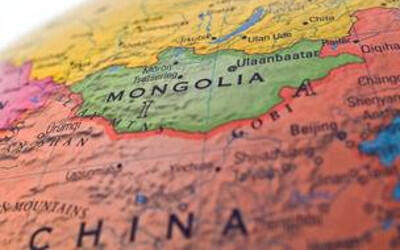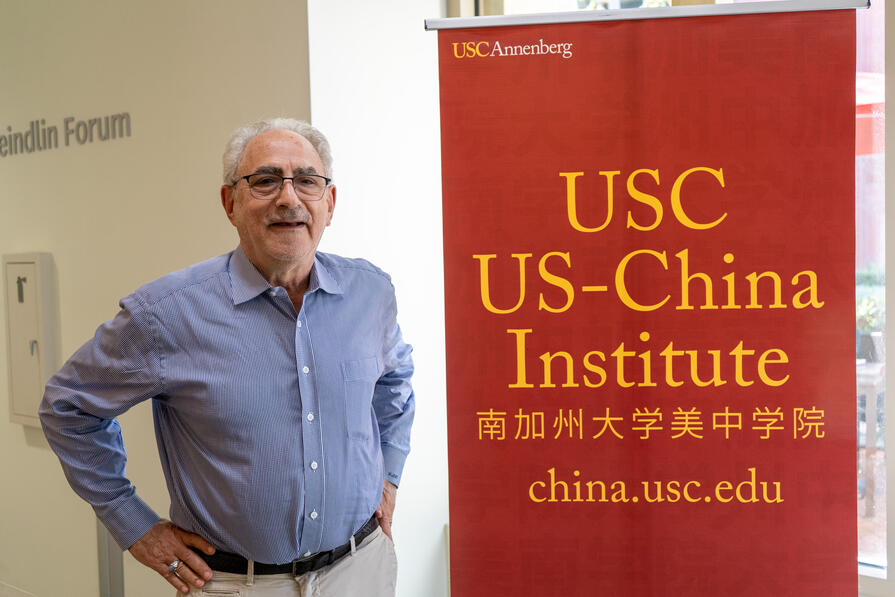by Bill Bikales
[Editor:This is a response to a presentation that Morris Rossabi made at USC in February 2018. Rossabi spoke on "China and Mongolia since 1990." Bill Bikales is an economist who has worked for a number of development agencies. At present, he is a Senior Development Economist for China and Mongolia at the United Nations Development Program. He has also spoken at USC, on poverty alleviation at our "Finding Solutions" conference in April 2018.]
Mongolia’s foreign relations are based on an oft cited “three neighbor” policy; i.e. Russia, China, and everyone else. That ‘third neighbor’ can be the US, or Japan, or the ROK, or Turkey or India or several other candidates. But Mongolia’s first priority is always maintaining good relations with the country’s two giant neighbors. Given the massive shift in relative power between those two in the last 30 years, and given Mongolia’s historic deep distrust of China, which Morris Rossabi described well, this is often a complicated task. Since its independence(1)in 1990 Mongolia has consistently pursued a multi-pronged network of foreign relations aimed at maintaining maximum flexibility and autonomy; close ties with Russia and China, who can balance each other’s influence somewhat, and constant pursuit of third neighbors who can help balance both.
But there is little question that the most important economic relationship for Mongolia is the one with China. China’s rapidly growing global presence is both a strategic threat and an enormous economic opportunity. Russia’s influence is a welcome counter-balance, but Beijing is 630 miles from Ulaanbaatar, and Moscow is nearly 3000 miles away. Furthermore, today’s warm ties between China and Russia somewhat reduce Russia’s usefulness as a counterweight to China, unlike the period 1960-1990 when Soviet aid poured into Mongolia, and 75,000 Soviet troops(2) were stationed there.
The Chinese and Mongolian economies are quite complementary; Mongolia’s abundant mineral resources and small labor base and China’s mammoth demand for commodity imports and large manufacturing sector. But given the history of relations between the two, Mongolian leaders are constantly aware of the need to avoid being overwhelmed by China’s huge economy, even as trade between them grows so rapidly.
That is why I’d like to describe the extraordinary event that took place in Mongolia on November 18, 2016.
Mongolia was in the midst of an extremely serious economic crisis. After three years of very rapid GDP growth from 2010-2012, a series of policy errors, compounded by a decline in the prices of Mongolia’s key commodity exports, had led to a rapid deterioration of growth to almost zero in 2016. FDI had plunged and official debt had soared. The budget deficit rose to nearly 20% of GDP, a staggering level. By late 2016 there were persistent rumors that Mongolia might default on a $550 million bond coming due in January, 2017, which would have sent the Mongolian economy into further turmoil.(3)
In June 2016 the opposition Mongolian People’s Party won parliamentary elections and formed a new government. That government immediately focused on reaching an agreement with the International Monetary Fund to avoid debt default. The agreement’s outlines quickly took form; a package of conditionalities; tighter budget, restoration of the health of the banking sector, no new high interest debt, a few others, based on which Mongolia would receive a large infusion of support from the World Bank, Asian Development Bank and bilateral sources including Japan, Republic of Korea, EU and others. One key piece of this was the need for the People’s Bank of China, China’s central bank, to renew its roughly $1.6 billion credit swap line with the Mongolian central bank, which was due to expire. Without that piece the whole package would fall apart.
At this moment, in November, as things seemed to be coming together, the President of Mongolia, Ts. Elbegdorj, unofficially ‘invited’ the Dalai Lama to visit Mongolia. This would be Dalai Lama’s ninth visit to Mongolia, whose traditional religion is Tibetan Buddhism, but his first in 10 years. Unlike past visits, this one was well known in advance of his arrival, and China quite publicly and sternly warned Mongolia not to let it proceed. The visit took place anyway.(4) On November 18 the Daiai Lama flew from Tokyo to Ulaanbaatar, where he spent four days. China was extremely unhappy and suspended talks about the IMF agreement and other matters, with the January maturation of that $550 million bond looming closer and closer. Mongolian coal exports to China, an important part of the national economy, were held up at the border.(5)
Finally at the end of December the Mongolian foreign minister visited Beijing, apologized and promised that the government would probably not allow any more visits by the Dalai Lama. As an observer I was a bit surprised that many observers saw this as a capitulation, as a triumph for China.(6) In hindsight it is clear that the people who saw it that way were my China watching friends who knew little about Mongolia. I did not share their view at all. The Mongolian apology and promise were both quite pro forma. The promise clearly was not a binding one for future Mongolian governments; in fact, that government lost a no confidence vote in the Parliament less than a year later, and has been replaced already.
Soon thereafter the IMF released a statement that made clear that the new agreement, although not formally approved by their Board, was in place. That was enough for Mongolia to refinance that January bond at much lower interest. And in May the IMF agreement was official, with an extension of the Central Bank swap line by China.
At a moment of extreme economic vulnerability Mongolia openly defied threats from China, its largest trading partner and on whose important further assistance Mongolia was counting, and allowed a high profile visit by the Dalai Lama, a step that many much less economically vulnerable foreign governments have hesitated to take. Bond fund managers and other outside observers wondered if Mongolia’s leaders had gone completely mad.
One other point to highlight here. When visitors fly into Ulaanbaatar they land at Chinggis Khaan International Airport. If they visit the Government office building in the center of town the first thing they see is a large statue of Chinggis, flanked by his warriors. Prior to Mongolia’s democratic revolution in 1990, when Mongolia was dominated by the Soviet Union, Chinggis Khan could not be mentioned, let alone publicly revered. The Russians did not view him as favorably as the Mongolians, not surprisingly, and they were nervous about a rise of Mongolian nationalism that could pose threats to Soviet domination. After 1990 the Chinggis tide rose steadily with stamps, songs, statues and much more.(7) Independent and free Mongolia has been able to embrace two key parts of its culture and history that has been suppressed during its Communist era; its Buddhism and its great national hero.
Mongolia is now heavily dependent on trade with China. That is an economic reality. But another way to put this would be; prior to 1990 Mongolia was completely dependent on the Soviet Bloc of countries, a grossly inefficient economic system that lasted as long as it did only because it erected huge barriers to protect its businesses from competition with higher quality products from outside their border, and eventually collapsed anyway. Now Mongolia is quite, but far from entirely, dependent on trade with one of the most dynamic, competitive, economies in the world, and through China is linked directly to the rest of Asia, the US and the rest of the world. Pre-1990 Mongolia’s main economic partners, other than the Soviet Union, were Poland, Czechoslovakia, Bulgaria and so on. Today, after China, in addition to Russia they are Japan, Korea, Singapore, the US, Germany and so on. This has meant a significant upgrading of living standards, beyond what can be captured in income measures. The variety of reasonably priced consumer goods that have been available since the 90s is much greater than previously.
An even clearer example of how Mongolia has benefited from economic links with China is the tremendous economic potential, only beginning to be tapped, of Mongolia’s mineral resources. As a landlocked country facing harsh climate conditions Mongolia would face many obstacles in exporting to most of the world.
Being right on the doorstep of China’s northern industrial heartland changes that calculus greatly in Mongolia’s favor.
At the same time, the need since 1990 to reorient trade away from former Soviet bloc partners and to new and much more competitive markets has made the challenges to Mongolian manufacturers even greater than might be obvious. Rossabi casually asserts that after 1990 Mongolian industry was needlessly allowed to collapse in the face of import competition. He cites the dramatic 1997 elimination of import tariffs by Mongolia as a major cause and suggests that ‘infant industry’ approaches would have been better. This reflects serious ignorance of conditions, and developments, in the post-1990 Mongolian economy.
Mongolia’s quite small manufacturing sector, including leather factories, was completely integrated into the Soviet bloc trading network pre-1990. Its technology, equipment, inputs and management techniques were all from those countries. Its products had never had to compete; they were all guaranteed markets in those countries. This is the opposite of an infant industry situation. In economic terms these were aged dinosaurs. And they were not abandoned. Throughout the 1990s there dozens of projects that aimed to help them, by the UN, EU, Japan, the big multilaterals, teaching them new management skills, linking them to potential new markets and suppliers and providing financial support to make them competitive. Banks and government continued to provide them favorable credit in many cases. The results were, in general, poor, because transforming these firms into globally competitors often proved impossible. By 1997, when Mongolia eliminated import duties in an attempt to capture the world’s attention and economic flows, this pattern was already quite clear.
Cashmere is one of the sectors that has survived and evolved, because the product has been of good enough quality to find new markets, despite difficult problems posed to Mongolian cashmere producers by Chinese buyers who seek to purchase all the good quality raw cashmere directly from herders. That has been a perennial problem since the 1990s. There has never been, and there is still not, an easy answer to this problem. Bans or high taxes on exports of raw cashmere have failed completely; the border is too porous and the herders too scattered to enforce it. There is still a vigorous discussion about how to continue upgrading Mongolian manufacturers’ competitiveness so that they can pay higher prices and obtain more of the cashmere. The economic growth in the South Gobi, fueled by mining, may allow the placing of some production there, closer to the herders. That might eventually help.
Summing up this small note on a big topic, Mongolia is very closely linked to China economically, but has demonstrated clearly, by its multi-directional foreign policy and the quite extraordinary events of last November, that it is prepared to do whatever it needs to maintain its independence in policy making. Whether it will succeed, and for how long, remains to be seen! But don’t underestimate the skillful way in which Mongolia is managing its foreign relations.
One final note. Rossabi harshly criticized a USAID-funded pension expert whom he says he met in 1998 and who, he claims, knew nothing about Mongolia and was proposing for Mongolia a pension system that was based on individual investment accounts. This is untrue. In 1998 there was intense debate about how to fix Mongolia’s pension system, which faced insolvency within a decade. Many different reform ideas were proposed by experts. There were indeed a few donor advisors recommending a move to a system like Kazakhstan’s, in which contributions were pooled and invested by a state investment fund (even they did not propose individual investment accounts.) There were some who took the 180 degree opposite position; support the existing system, however much it costs. But where that money was to come from was not clear. It was in response to these conflicting and confused messages coming from the big international donors that Ms. H. Hulan, the Chair of the Parliamentary Standing Committee on Social Policy, and no radical free marketeer, asked my USAID-funded project to help her develop a workable, centrist reform. That’s the work that the advisor whom Rossabi met was leading. He spent many months in Mongolia on several visits, traveled around the country and worked closely with Ms. Hulan. The outcome was a very moderate reform called a ‘notional defined contribution’ approach. It passed the Parliament in 1999, at a time when the political situation was quite ugly, a testament to Ms. Hulan’s credibility and the moderation of the proposal.
As to ‘shock therapy’ and the role of the IMF et al, instead of replying to Rossabi’s quite distorted account here, I will simply refer you to an interview I gave 18 months ago to the Mongolia team at the University College of London’s Emerging Subjects project. And I would welcome further discussions with any of you who are interested in Mongolia, an extraordinary country and people. Thank you.
Notes:
Notes:
1. Meaning genuine independence, not the paper independence but actual total subservience to the USSR that had been Mongolia’s status from 1921-1989.
2. http://factsanddetails.com/central-asia/Mongolia/sub8_2e/entry-4604.html#chapter-10 The author cites Library of Congress documents as his source, but does not provide details.
3. See, e.g., my Wall Street Journal piece from August, 2016. https://www.wsj.com/articles/mongolia-faces-a-debt-crisis-1470331031
4. https://www.nytimes.com/2016/11/20/world/asia/mongolia-dalai-lama-china.html?_r=0
5. https://www.aljazeera.com/news/2016/12/china-blocks-mongolia-border-dalai-lama-visit-161210060313417.html also https://www.sundayguardianlive.com/news/7566-dalai-lama-s-visit-mongolia-angers-china
6. See, for example, https://www.nytimes.com/2016/12/30/world/asia/china-mongolia-dalai-lama.html




